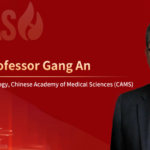Leukemia is a serious disease that poses a significant threat to public health, characterized by high mortality rates and challenging treatments. Fortunately, recent years have witnessed remarkable progress in the treatment of leukemia. On the morning of January 6th, the 4th China Hematology Development Conference was held in Tianjin. Continuing with the theme of "Broadening Hematology, Healthcare, and Wellness," the conference focused on the core development directions of hematology in China and explored the cutting-edge knowledge in the wake of innovative trends. "Oncology Frontier - Hematology Frontier" had the privilege of interviewing Professor ChunYan Ji from Shandong University's Qilu Medical College at the event, where he shared insights on the advancements and value of leukemia research.
“Oncology Frontier – Hematology Frontier“: As the chairman of the “Leukemia” session, could you discuss the significant research advancements in the diagnosis and treatment of leukemia in recent years, especially in the past year?
Professor ChunYan Ji : The field of leukemia has now entered an era of targeted therapy, with most advancements concentrated in this area. For instance, in Acute Myeloid Leukemia (AML), there have been significant developments with FLT3 inhibitors, IDH1 inhibitors, IDH2 inhibitors, and other targeted therapies, including both monotherapy and combination treatment strategies.
In the area of Acute Lymphoblastic Leukemia (ALL), several highlights include the CD19 CAR-T cell therapy developed under the leadership of Professor Wang Jianxiang, which has been successfully approved for the market. Additionally, there are other two significant treatments – the BiTE therapy and ADC drugs. These new technologies have notably improved treatment outcomes, enhancing both remission rates and survival. In Chronic Myeloid Leukemia (CML), this year’s ASH conference and other meetings reported on third-generation TKI research, showing promising effects in patients with the T315I mutation or multiple drug resistances. The conference also highlighted advancements in treatment-free remission (TFR) and the pursuit of a higher quality of life. Previously, our treatment goal was to achieve remission, but now CML can be managed as a chronic disease, with the potential for discontinuing medication in the future, thereby elevating treatment goals.
“Oncology Frontier – Hematology Frontier“: Last November, you and your team published a paper in Nature Communications on the differentiation mechanism of AML. Could you share more about this research and its clinical significance?
Professor ChunYan Ji : This study is actually part of a series of research projects our team is working on. We have been seeking new therapeutic targets to enhance the effectiveness of targeted treatments. In this research, we explored phase separation, using liquid-liquid phase separation to find treatment strategies, aiming to improve patient outcomes. Our team is not only engaged in clinical research but has also developed an auxiliary diagnostic and treatment system. This system incorporates our research findings to assist doctors in identifying optimal treatment strategies, further improving treatment efficiency and contributing to the development of the leukemia field in China.
“Oncology Frontier – Hematology Frontier“: At the conference, you also reported on “Progress in the Diagnosis and Treatment of Chronic Myeloid Leukemia (CML).” We know that the advent of TKIs has greatly improved the prognosis for CML patients, but they also face the issue of drug resistance. Could you talk about the new breakthroughs in overcoming TKI resistance?
Professor ChunYan Ji : As mentioned earlier, the treatment of chronic myeloid leukemia has made significant strides. However, a small subset of patients still develop primary resistance or resistance after treatment. For these resistant patients, recent studies have shown that third-generation TKIs can overcome the T315I mutation. Moreover, the domestically developed original drug, Orelabrutinib, has been reported at this year’s ASH conference in multiple studies, offering more possibilities for improving patient outcomes. Additionally, the old drug interferon has found new applications. This year’s ASH and other conferences reported on the efficacy of TKI combined with interferon therapy.
Currently, our treatment goals are continuously evolving. The past objective was to achieve remission in patients, but the future goal is not only remission but also to provide patients with better treatment outcomes and a higher quality of life. We aim to manage CML as a chronic condition and, ultimately, to stop medication, allowing patients to achieve a cure. In summary, the field of leukemia treatment has made impressive progress, improving the quality of life for many patients.

Professor ChunYan Ji
Distinguished Professor and Eminent Talent of Shandong University, Taishan Scholar Climbing Plan Expert, Chairman of the Hematologic Oncology Committee of the Chinese Anti-Cancer Association, Vice Chairman of the Hematology Institutions Branch of the Chinese Hospital Association, National Health and Family Planning Commission Outstanding Mid-career Expert, Recipient of the State Council Special Allowance, Outstanding Discipline Leader in Shandong Provincial Health System, Director of the Cancer Center of Qilu Hospital of Shandong University, Vice Chairman of the Hematologic Oncology Committee of Shandong Anti-Cancer Association, Member of the Hematology Committee of the Chinese Medical Association, Director of the Intelligent Diagnosis and Treatment Joint Laboratory for Hematologic Diseases of Shandong University, and Chairman of the Hematology Committee of Shandong Medical Association.


